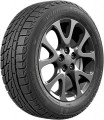Orientation
The shape of the tyre tread pattern:
—
Directional. Pattern with a characteristic V-shape. Among other things, such rubber is considered to be especially effective on wet surfaces — in rain, on snow, with an abundance of melt water, etc.: the pattern provides effective water drainage, reducing the risk of hydroplaning and increasing grip. Also, these tyres are well suited for high-speed sports cars (although, of course, their speed rating and specialization may be different). When installing directional tyres, the direction indicated by the manufacturer must be kept.
—
Symmetric. The pattern without signs of directionality is the same both on the outer and on the inner part of the tread. These tyres are easier to manufacture than directional or asymmetric tyres, and are generally cheaper, while still having good performance on a flat and dry surface. In addition, symmetric tyres are as simple as possible to install, they do not need to follow the direction. However, for hard conditions, particularly wet weather, they are poorly suited. So, typically, such tyres are designed mainly for city cars used on short trips on relatively high-quality roads.
—
Asymmetric. Tyres with a different pattern inside and outside the tread. Each of these parts plays a role: the inner part provides water evacuation and reduces the risk of aquaplaning, while the ou
...ter part provides the necessary rigidity for manoeuvrability and stability. While installing, you need to take into account the location of the outer and inner sides, they usually have the appropriate marking. Asymmetric tyres are considered the most advanced, although, of course, the actual characteristics and cost of such products may vary, depending on the brand and the general level. Such tyres are designed mainly for cars of medium and top levels; they are often supplied as factory equipment for advanced cars.Fuel efficiency
The rolling resistance rating that the tyre corresponds to. The higher this figure, the lower the resistance, the less fuel is spent to overcome it and the more economical the tyre is. Efficiency indices are denoted by letters of the Latin alphabet in descending order of efficiency:
A(highest efficiency),
B,
C,
D,
E,
F,
G(lowest efficiency).
With other things being equal, more economical tyres tend to cost more, but the difference is offset by fuel economy.
Wet Grip
An index that determines the overall performance of a tyre on wet pavement. Lettered from
A(highest) to
G(lowest); intermediate options, respectively —
B,
C,
D,
E and
F.
The higher this indicator, the stronger the tyre grips to the wet road, the more efficient and safer it will be in difficult weather conditions. At the same time, it is worth noting that a low grip index does not mean unsuitability for driving in rain or snow — you just need to be more careful using such tyres. Conversely, a high index does not relieve the driver of the need to be careful in difficult weather conditions.
Noise Level
The average noise level created by a tyre while driving. The lower this indicator, the more comfortable this model will be, the less additional noise it will create.
Note that EU rules provide 3 categories of tyres in terms of noise.
“Quiet” are considered models with an index of up to 68 dB,
“medium” — 68 – 71 dB,
“loud” — 72 dB and above.
Homologation for
Recommendations of the vehicle manufacturer regarding the ideal tires for a specific car model.
Homologated tires take into account the technical and design features of machine, right down to the factory suspension settings, which helps to reveal the full potential of the "iron horse". Manufacturer-approved tires are recommended to be installed only on the wheels of suitable cars, and in some cases, without the use of homologated tires, machine risks losing its warranty. The sharpening of tires for a specific brand and model of car is indicated by specialized homologation markings.
The shelves of tire stores most often feature homologated tires for the following brands of cars:
Audi(including
Audi RS,
Alfa Romeo,
BMW / Mini,
Ferrari,
Mercedes-Benz(including
Mercedes AMG),
Maserati,
Porsche,
Tesla,
Volvo,
Volkswagen.

